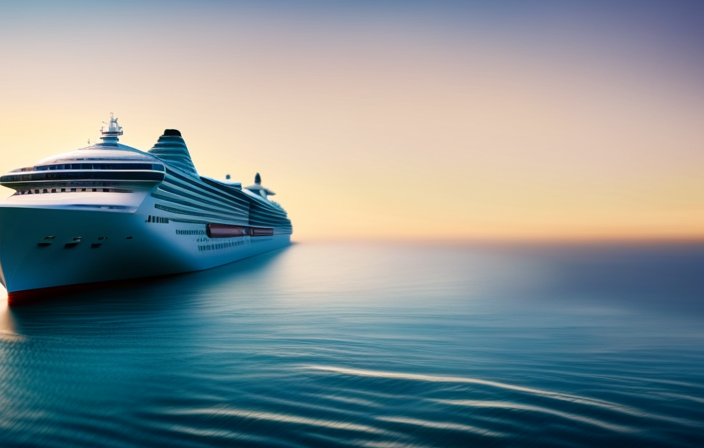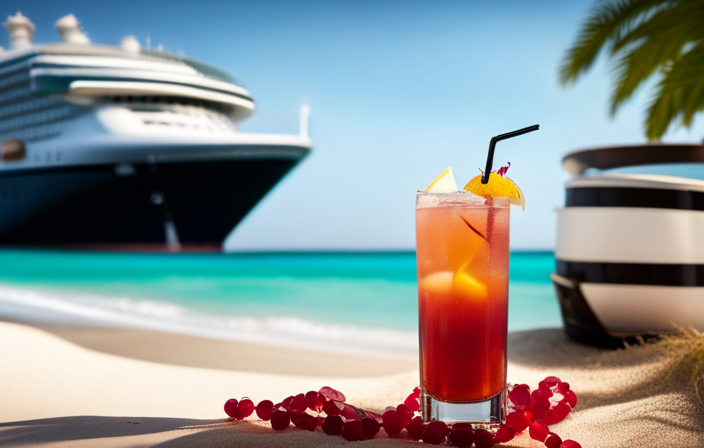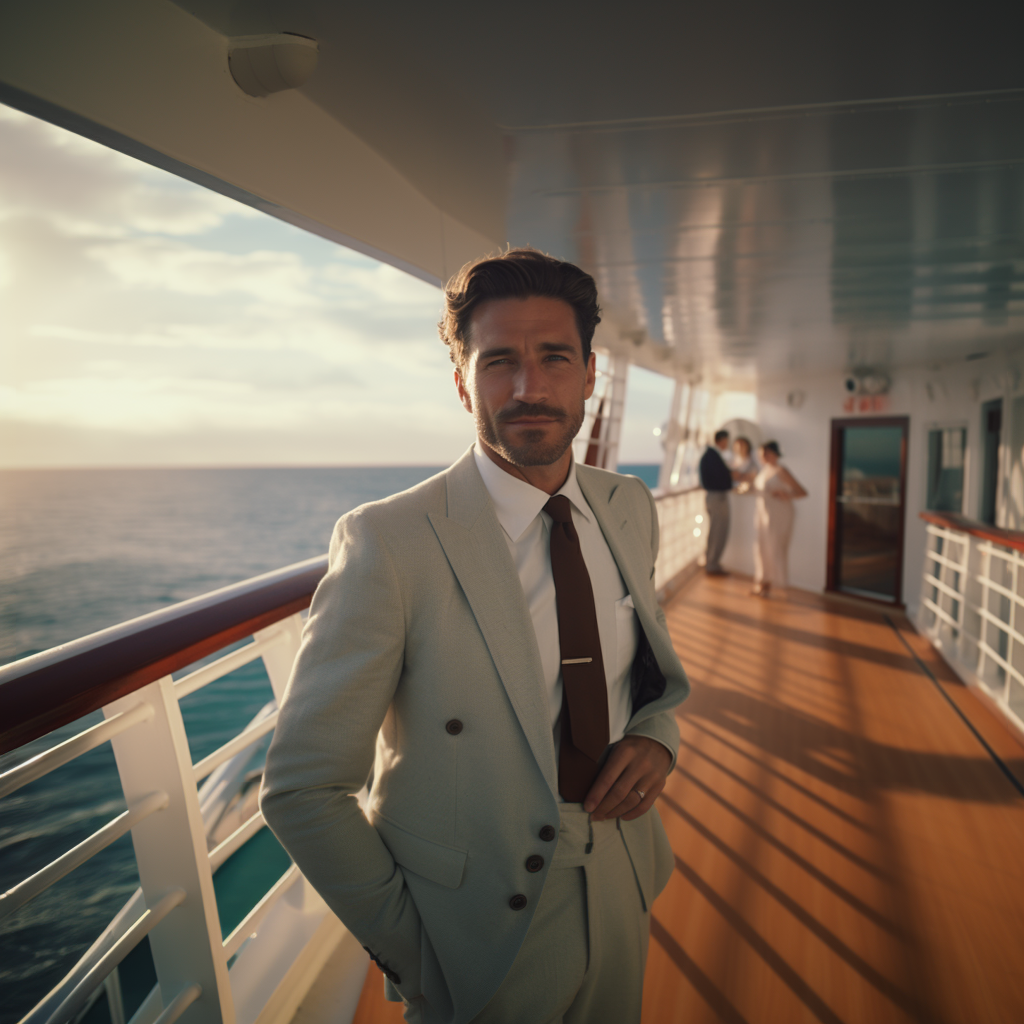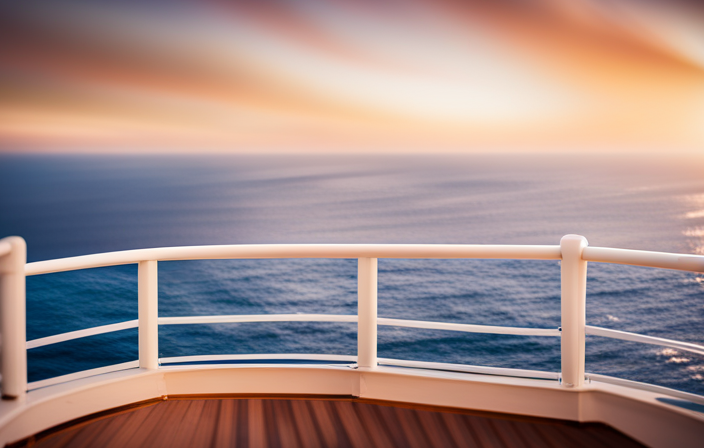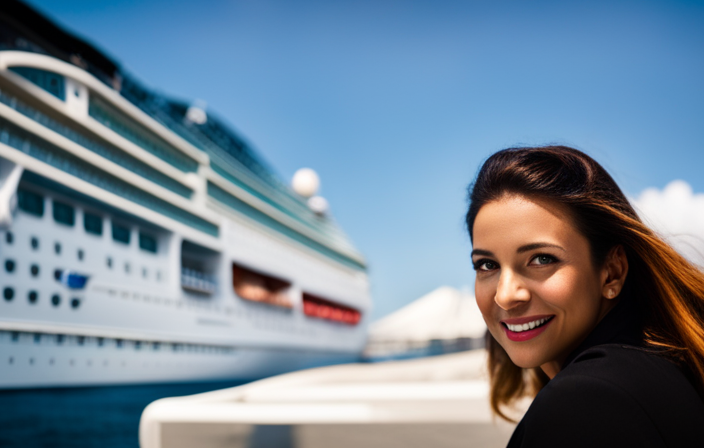Have you ever pondered the reasons behind the sluggish speed of cruise ships?
Picture this: you’re standing on the deck of a majestic cruise ship, the wind blowing through your hair, and the sun setting on the horizon. As you look out at the vast expanse of the ocean, you might think to yourself, ‘Why aren’t we going faster?’
Well, the answer lies in a combination of factors that prioritize safety, efficiency, and passenger enjoyment.
One example that highlights the importance of cruising at a slower speed is the issue of stability on the water. By maintaining a slower pace, cruise ships are able to navigate through rough seas with greater ease, minimizing the risk of capsizing or other accidents.
Additionally, slower speeds allow for better fuel efficiency, reducing the environmental impact of these massive vessels.
But it’s not just about practicality; cruising at a leisurely pace also allows passengers to fully enjoy the journey, take part in onboard activities, and indulge in the relaxation and stress relief that a slower pace can provide.
So, the next time you find yourself on a cruise ship, embrace the slower speed and savor every moment of your maritime adventure.
Key Takeaways
- Adhering to regulations and speed limits ensures safety, security, and minimizes environmental impact.
- Access to smaller ports and destinations is made possible by investing in smaller vessels, benefiting local communities.
- Cruise ships provide a tranquil and relaxing atmosphere, offering various activities and facilities for stress relief and mental well-being.
- Cruise ships showcase maritime history and traditions through guided tours, exhibitions, and demonstrations, emphasizing the preservation of seafaring heritage.
Safety and Stability on the Water
Cruise ships go at a leisurely pace to ensure safety and keep everyone on board feeling stable. The speed of a cruise ship is carefully regulated to navigate through water currents and minimize the impact on marine life. By moving at a slower speed, the ship can easily maneuver and avoid any potential hazards in the water.
Additionally, slower speeds provide a smoother ride, reducing the chances of passengers experiencing motion sickness or discomfort. Moreover, moving at a slower pace allows the ship’s crew to maintain better control and respond promptly to any emergencies or unexpected situations that may arise.
As we transition into the subsequent section about fuel efficiency and environmental impact, it’s important to note that the slower speed of cruise ships also contributes to their lower fuel consumption and reduced carbon emissions.
Fuel Efficiency and Environmental Impact
Hop on board a majestic vessel and you’ll quickly discover the allure of leisurely speeds, as fuel efficiency and minimizing environmental impact become paramount. Cruise ships are designed to operate at slower speeds to optimize fuel consumption and reduce carbon emissions. This deliberate choice allows ships to maximize their fuel efficiency, ensuring a smooth and steady journey for passengers. The industry is constantly exploring innovative ways to further improve fuel efficiency, such as implementing advanced propulsion systems and optimizing hull designs. By prioritizing fuel efficiency, cruise lines are not only reducing their operational costs but also minimizing their impact on the environment.
As we navigate the topic of fuel efficiency and environmental impact, we can now transition into the subsequent section about the enjoyment of the journey, where we explore the various amenities and activities available on board.
Enjoyment of the Journey
Once on board, passengers can immerse themselves in a world of luxurious amenities and exciting activities, creating unforgettable memories along the way. Cruise ship design plays a crucial role in ensuring passenger comfort during the journey.
These massive vessels are carefully crafted to provide stability and minimize the impact of rough seas. The design incorporates features such as stabilizers and anti-roll tanks, which help to reduce the ship’s motion and create a smoother sailing experience.
Additionally, the ship’s layout is meticulously planned to maximize space utilization and minimize the feeling of being confined. From spacious cabins to expansive open decks, every aspect is designed with passenger comfort in mind.
This attention to detail not only enhances the enjoyment of the journey but also reduces the risk of seasickness, allowing passengers to fully embrace the adventure that awaits.
Reduced Risk of Seasickness
Passengers can easily relax and enjoy the journey without worrying about feeling queasy or experiencing motion sickness thanks to the meticulously designed cruise ship. The reduced comfort of a fast-moving ship can often lead to an unpleasant experience for passengers, as the constant rocking and swaying can cause seasickness. However, cruise ships are intentionally designed to have a slower speed to minimize this discomfort. Here are four reasons why the reduced speed of cruise ships helps to reduce the risk of seasickness:
-
Stability: Slower speeds allow for better stability, as the ship can navigate through waves more smoothly, minimizing the side-to-side motion that often leads to seasickness.
-
Reduced vibrations: Slower speeds result in reduced engine vibrations, which can contribute to a more comfortable and pleasant experience for passengers.
-
Enhanced maneuverability: Cruise ships need to make precise turns and navigate through narrow channels. Slower speeds allow for better maneuverability, reducing the chances of sudden jolts or jerks that can trigger motion sickness.
-
Improved stabilization technology: Modern cruise ships are equipped with advanced stabilization technology that further minimizes the rolling and pitching motions, ensuring a smoother and more enjoyable journey.
With the reduced risk of seasickness, passengers can fully embrace the opportunity for onboard activities and entertainment, creating memorable experiences during their cruise vacation.
Opportunity for Onboard Activities and Entertainment
Get ready to immerse yourself in a world of excitement and entertainment as you explore the endless opportunities for onboard activities on your cruise vacation. Cruise ships are designed to provide a wide range of onboard amenities to cater to every traveler’s interests and preferences.
From swimming pools and sports facilities to spa treatments and fitness centers, there’s something for everyone. In addition, live entertainment is a highlight of any cruise experience. Enjoy Broadway-style shows, live music performances, comedy acts, and more, all conveniently located on the ship.
These onboard activities and entertainment options ensure that there’s never a dull moment during your cruise. As you transition into the next section about ‘better views and photo opportunities’, you’ll discover that the excitement extends beyond the ship itself.
Better Views and Photo Opportunities
While the opportunity for onboard activities and entertainment is certainly a highlight of cruising, another benefit of the slower speed of cruise ships is the chance to enjoy better lighting and unique perspectives for stunning views and photo opportunities.
Cruise ships often sail at a leisurely pace, allowing passengers to bask in the golden hues of sunrise or sunset, which create the perfect lighting conditions for capturing memorable moments. Additionally, the slower speed allows for a closer look at landmarks, coastlines, and wildlife, providing passengers with an up-close and personal experience that can’t be replicated on land.
From the deck of a cruise ship, one can witness breathtaking vistas and capture stunning photographs that are truly one-of-a-kind. With these incredible views and photo opportunities, passengers can fully immerse themselves in the beauty of their surroundings.
As we transition to the next section about the preservation of historic maritime traditions, it becomes evident that the slower speed of cruise ships also plays a significant role in honoring and upholding these cherished customs.
Preservation of Historic Maritime Traditions
As you step on board, you’ll be transported back in time as historic maritime traditions are lovingly preserved and celebrated. The preservation of historic maritime architecture is a key aspect of cruise ship design. These beautiful vessels are constructed with great care to reflect the cultural significance of traditional maritime practices.
From the elegant lines of the hull to the intricate detailing of the decks, every aspect of the ship pays homage to the rich history of seafaring. Onboard, you’ll find a range of experiences that showcase this preservation, including guided tours of the ship’s architecture, exhibitions of maritime artifacts, and even demonstrations of traditional sailing techniques. By immersing guests in the past, cruise ships provide a unique cultural experience that connects us to our maritime heritage.
Transitioning into the subsequent section about ‘compliance with maritime regulations’, it is important to note that while cruise ships prioritize the preservation of historic maritime traditions, they also adhere to strict regulations to ensure the safety and security of all passengers and crew.
Compliance with Maritime Regulations
Preserving historic maritime traditions is just one reason why cruise ships tend to go slow. However, another important factor that influences their speed is compliance with maritime regulations.
Cruise ships are required to adhere to specific speed limits set by maritime law to ensure the safety of passengers, crew, and the environment. These regulations are put in place to prevent accidents and minimize the impact of cruise ships on marine ecosystems. By following speed limits, cruise ships can reduce their carbon footprint and avoid disturbing marine life. Additionally, adhering to maritime regulations allows for more efficient navigation and improves the overall safety of the ship.
Transitioning to the next section, the adherence to speed limits also affects cruise ships’ access to smaller ports and destinations, making it a crucial aspect to consider.
Access to Smaller Ports and Destinations
Another reason cruise ships love to explore smaller ports and destinations is because it allows them to immerse passengers in unique and off-the-beaten-path experiences. Accessibility plays a key role in determining which ports and destinations cruise ships can visit. Smaller ports often have shallower waters and narrower channels, making it difficult for larger ships to navigate. However, cruise lines have been investing in smaller vessels that can access these ports, allowing passengers to explore hidden gems that are inaccessible to larger ships. The economic impact of cruising on these smaller ports cannot be underestimated. These destinations heavily rely on the revenue generated by cruise ship tourists, and the influx of passengers has a significant positive effect on the local economy. By supporting these smaller ports, cruise ships contribute to the sustainability and growth of local communities. Furthermore, the slower pace of exploration in smaller ports enhances relaxation and stress relief, offering passengers a truly rejuvenating experience.
As we delve into the subsequent section about ‘enhanced relaxation and stress relief’, passengers can further unwind and rejuvenate onboard cruise ships.
Enhanced Relaxation and Stress Relief
Indulge in the ultimate relaxation and find solace in the tranquil atmosphere onboard, as you surrender to the gentle sway of the ship and immerse yourself in the soothing rhythms of the ocean. Cruise ships are intentionally designed to go slow to enhance relaxation and provide stress relief for passengers.
Here are four ways they achieve this:
-
Serene Environment: Cruise ships are equipped with state-of-the-art soundproofing materials to minimize external noise, creating a peaceful ambiance for passengers.
-
Spa Facilities: Most cruise ships offer a variety of relaxation techniques such as massages, facials, and yoga classes to promote mental well-being.
-
Onboard Activities: From meditation sessions to tai chi classes, cruise ships provide a range of activities that help passengers unwind and destress.
-
Ocean Views: Slow cruising allows passengers to fully appreciate the breathtaking scenery, offering a sense of tranquility and peace.
By prioritizing relaxation and mental well-being, cruise ships provide an ideal environment for passengers to escape the fast-paced world and rejuvenate their mind, body, and soul.
Frequently Asked Questions
How much does it cost to book a cruise ship?
Booking a cruise ship can cost anywhere from a few thousand dollars to several hundred thousand, depending on factors like the ship’s size and amenities, the length of the trip, and the popularity of the destination. Popular cruise destinations include the Caribbean, Mediterranean, and Alaska.
Are there any age restrictions for passengers on cruise ships?
Yes, there are age restrictions for passengers on cruise ships. These restrictions are in place to ensure cruise ship safety and vary depending on the cruise line and specific itinerary.
Can I bring my pet on a cruise ship?
Cruise ships offer pet-friendly accommodations with specific pet policies in place. For example, some cruise lines allow pets in designated areas or offer pet-friendly cabins. It’s important to research and follow the cruise line’s guidelines before bringing a pet onboard.
Do cruise ships have medical facilities on board?
Cruise ships have medical facilities on board with qualified medical staff. They are equipped to handle a range of medical emergencies and have a supply of medications available for passengers’ needs.
Are there any special dietary options available on cruise ships?
Special dietary needs are catered to on cruise ships, including vegetarian options. The chefs prepare a variety of dishes specifically tailored to meet these requirements, ensuring all guests can enjoy their meals onboard.
Conclusion
In conclusion, the slower speed of cruise ships serves several important purposes. It prioritizes the safety and stability of passengers and crew while maximizing fuel efficiency and reducing the environmental impact. The slower pace also allows for a more enjoyable journey, with ample opportunities for onboard activities and entertainment. It helps minimize the risk of seasickness and allows access to smaller ports and destinations. Overall, the slower speed enhances relaxation and stress relief while preserving historic maritime traditions.
So next time you’re on a cruise, embrace the slower pace and savor the experience.
Alfons is the visionary leader and driving force behind Voyager Info’s success. As the Editor in Chief, he brings a wealth of experience and an unwavering passion for travel to the helm of our cruise-centric platform.
With a lifelong fascination for exploring new horizons, Alfons discovered his love for the ocean and cruising at a young age. From sailing across pristine Caribbean waters to embarking on daring expeditions to far-flung destinations, he has amassed a treasure trove of first-hand experiences in the world of cruising.

